According to findings from the National Highway Traffic Safety Administration (NHTSA), faulty or malfunctioning headlights can elevate the likelihood of accidents. So for a safer ride, healthy headlights are a must. Many owners have trouble with their headlights. Like, bulbs burning out often, flickering lights, water getting in, and lights not shining well. These problems make driving less safe, especially at night or when it’s dark.
Here, we’ll delve into the common Ford Ranger headlight problems and discover their real-time solutions to assist you in identifying issues and ensuring safer, more enjoyable drives. Thus this practical guide is beneficial for both owners and potential buyers of Ford Rangers.
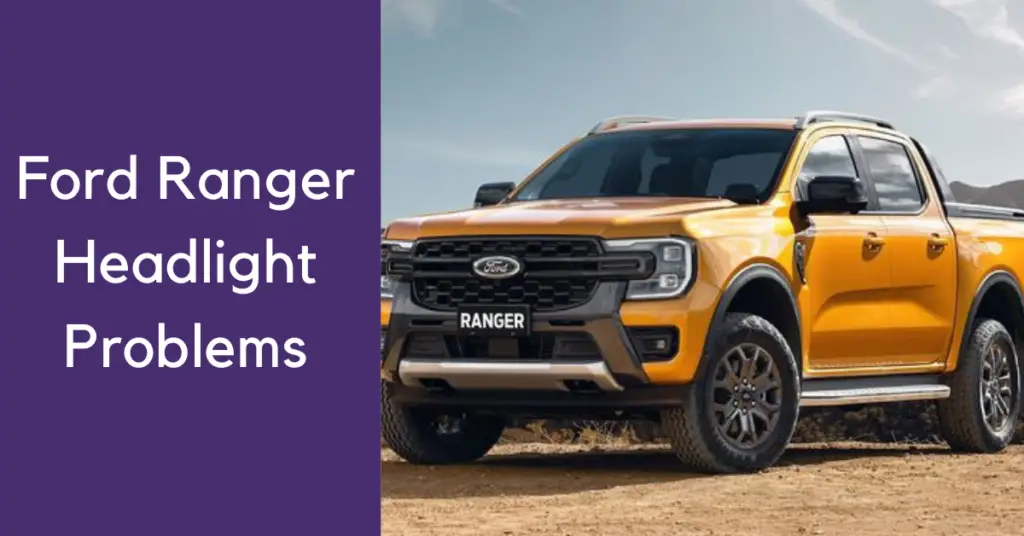
Following Are Some Ford Ranger Headlight Problems
#1. Parking Lights Not Working
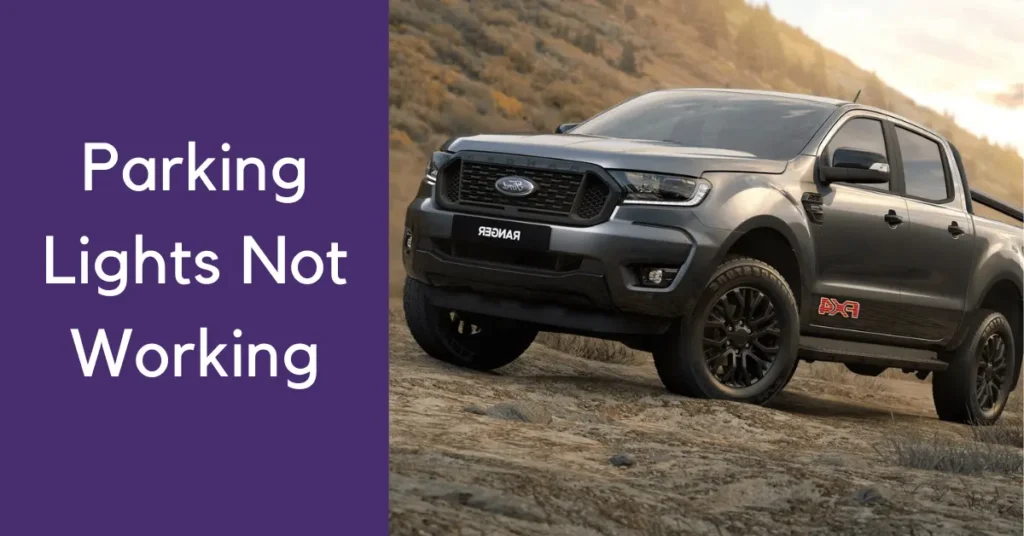
Sometimes front and back parking lights of the Ford Ranger might not turn on when you want them to. This can be a safety concern, especially during low-light conditions. Because it reduces the vehicle’s visibility to other drivers.
Two common reasons for parking lights malfunction in the Ford Ranger are blown fuses and burnt-out bulbs. Fuses act as safety switches, protecting the electrical circuit from overloads. If a fuse responsible for the parking lights blows, it cuts off power to the circuit. This causes the lights to turn off.
Additionally, like any other light bulb, the parking light bulbs can wear out over time because they’re used a lot. They can also get damaged by things like water or changes in temperature. Plus, being on the road can shake them up, causing them to wear out faster. This can make the bulbs dim or stop working altogether.
How to Fix It?
When a fuse is blown out, it needs replacement. While we can provide a general outline for replacing a blown fuse in a Ford Ranger, it’s essential to recognize the potential dangers of electrical work. Therefore, it’s highly recommended to refer to your car’s manual or enlist the assistance of a qualified mechanic. Nonetheless, here’s a basic rundown of how to replace a blown fuse:
- Start by turning off the engine and all electrical components.
- Find the fuse box. It is usually located beneath the dashboard or in the engine bay, consult your manual for its exact position.
- Identify the blown fuse, which may appear damaged or discolored.
- Carefully remove the blown fuse using a fuse puller or needle-nose pliers to avoid injury.
- Replace the blown fuse with one of the same ampere ratings as the original. Ensure not to use a higher-rated fuse to prevent electrical damage.
- Press the new fuse securely into place within the socket.
- Restore power to your car’s electrical system and verify if the parking lights are functioning correctly.
Remember to never use a fuse with a higher rating than the original one for the Ford Ranger. If the new fuse blows immediately, there may be a more serious underlying electrical issue requiring professional attention. In case, there is a bulb burnout, you need to replace it with a new one. Here are the simple steps to replace a burnt-out bulb:
- Turn off your car’s engine and lights.
- Find the bulb housing, usually behind the headlight.
- Remove the old bulb by twisting or pulling it out gently.
- Check the bulb for damage. If burnt, remove it.
- Secure the new bulb in place.
- Turn on your car’s lights to test the new bulb.
#2. Ford Ranger’s Dim Headlights
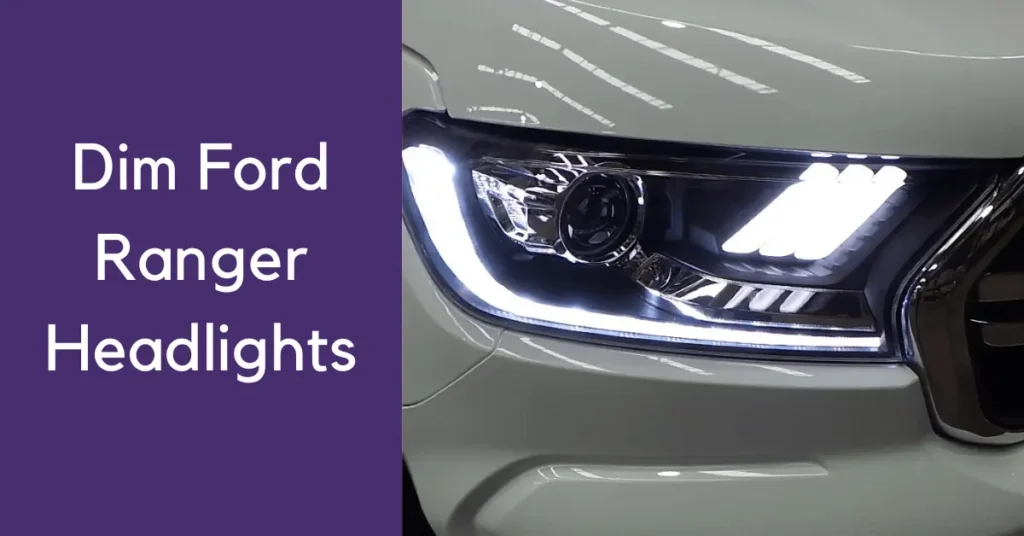
Dim headlights are headlights that do not shine as brightly as they should. They don’t provide enough light to see the road. This can make it difficult to drive safely, especially at night. Dimming is one of the prominent Ford Ranger headlight problems. This is a common issue with several potential causes.
One culprit could be a faulty voltage regulator because it controls how much electrical power goes to your headlights. When it malfunctions, it can deliver irregular voltage. This leads to the dimming of lights. Another possible factor behind dimming is a weak or dying battery. Headlights require a significant amount of power to function properly. A weak battery can’t provide enough power. This results in dimmed illumination.
How to fix it?
To check if the Ford Ranger voltage regulator is faulty, you can perform a simple test using a multimeter. Start by disconnecting the battery and then removing the voltage regulator from the vehicle. Set your multimeter to the voltage setting and connect the probes to the regulator’s terminals. With the engine running, check the voltage output. If the reading fluctuates significantly or exceeds the recommended range, the voltage regulator is likely faulty.
To fix it, you’ll need to replace the faulty regulator with a new one. To install a new one, first, ensure the engine is off and the battery is disconnected. Remove the old regulator by disconnecting electrical connectors and mounting bolts, then carefully detach it. Position the new regulator in place, align it with mounting holes, and secure it with mounting bolts. Reconnect electrical connectors and ensure they are properly seated. Finally, reconnect the battery to complete the installation process.
If you’ve got a dry weak battery, you’ll likely need to replace it with a new one. Swap out the old battery for a new one. So your Ford Ranger headlights should be back to shining brightly.
#3. Headlight Moisture Buildup
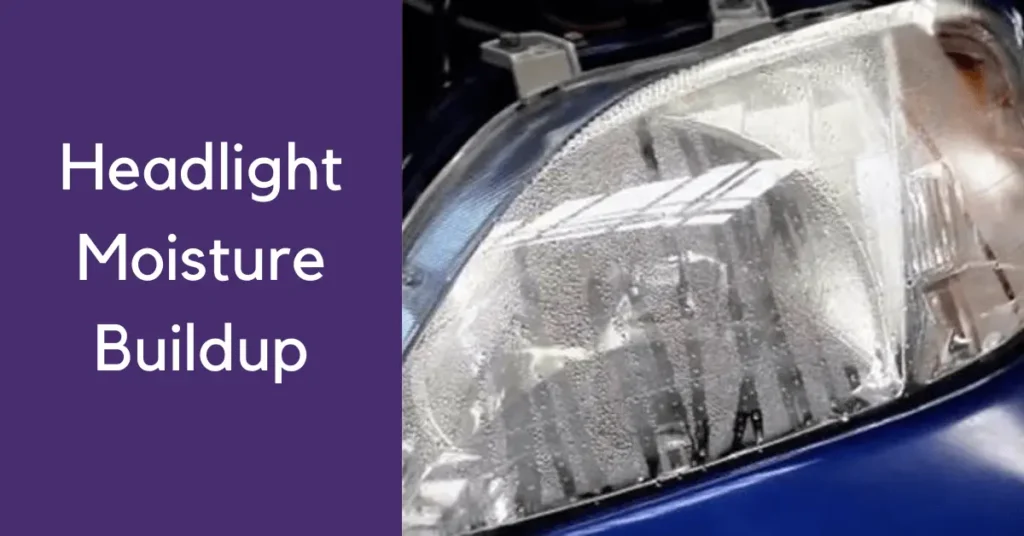
If you own a Ford Ranger, you might notice that your headlights look cloudy or foggy. This can make it hard to see at night and can be dangerous. It happens because water gets trapped inside the headlights. Visible fogging or water droplets within the headlight housing, reduced light output and malfunctions like flickering are all signs of moisture buildup.
There are a few reasons why water might build up inside your headlights. Mainly, if the headlight cover is cracked or broken, water can get in and cause condensation. Poor ventilation can also trap moisture inside, making the headlights foggy. Even sudden temperature changes can make condensation form inside the headlights.
How to fix it?
First, check for any cracks or openings in the headlight housing that might let moisture in. If you find any, seal them up with silicone sealant. This prevents further moisture intrusion into your Ford Ranger headlights. Next, you can try removing the headlight assembly and using a hairdryer or heat gun. Use it to gently dry out the inside. Be careful not to overheat the plastic and cause damage.
Once the inside is dry, consider adding small packets of silica gel or desiccant inside. This can absorb any remaining moisture. Finally, make sure your headlights are properly sealed. Then reassemble them securely to keep moisture out of your Ford Ranger headlights in the future.
#4. Ford Ranger’s Low or High Beams Not Working
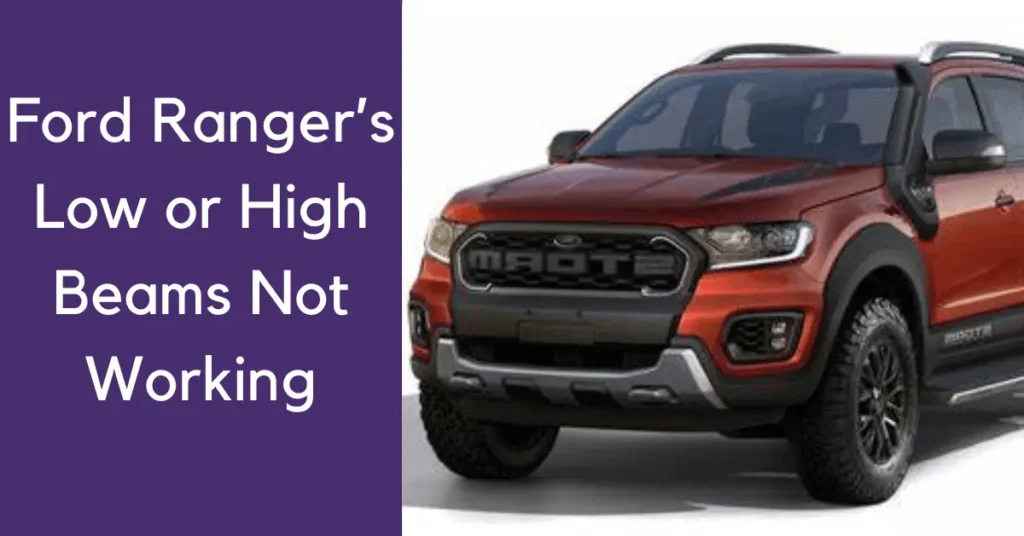
Amongst the various Ford Ranger headlight problems, one is low or high beam malfunction. Many Ford Ranger owners have faced problems where their low or high beams stop working.
When your Ford Ranger’s low or high beams don’t work, it’s usually because of a few common problems. One factor is a broken switch called a headlight relay that controls the power to the headlights. The beams won’t light up if this switch isn’t working right. Another problem could be that the light bulbs themselves are burned out, just like a regular bulb in your house. Lastly, sometimes the lever you use to signal when you’re turning can mess with the headlights if it’s not working properly.
how to fix it?
To fix these issues in the Ford Ranger, start by checking the headlight relay and ensuring it’s functioning correctly. If the relay is damaged or faulty, replacing it may resolve the issue of your low or high beams not working. Additionally, inspect the light bulbs themselves to see if they are burned out and need to be replaced. It’s also a good idea to examine the turn signal lever to rule out any potential interference with the headlights.
Next, evaluate the headlight switch for wear or damage. Toggle it on and off to detect irregularities in beam output or unusual sounds. If necessary, replace the switch to address any identified issues.
Finally, inspect the wiring harness and connectors for damage, corrosion, or loose connections. You can use a multimeter to test continuity and identify faulty components in your Ford Ranger. Repair or replace damaged wiring or connectors as needed to restore proper functionality. These steps collectively form a systematic approach to troubleshooting headlight issues.
Subreddit for discussion with experts and other users on this topic
Headlight Problems in Other Ford Models:
- Ford Kuga headlight Problems
- Ford figo headlight problems
- Ford focus headlight problems
- Ford B Max headlight problems
- Ford escape headlight problems
- Ford Flex Headlight Problems
#5. Ford Ranger’s Headlights Flickering
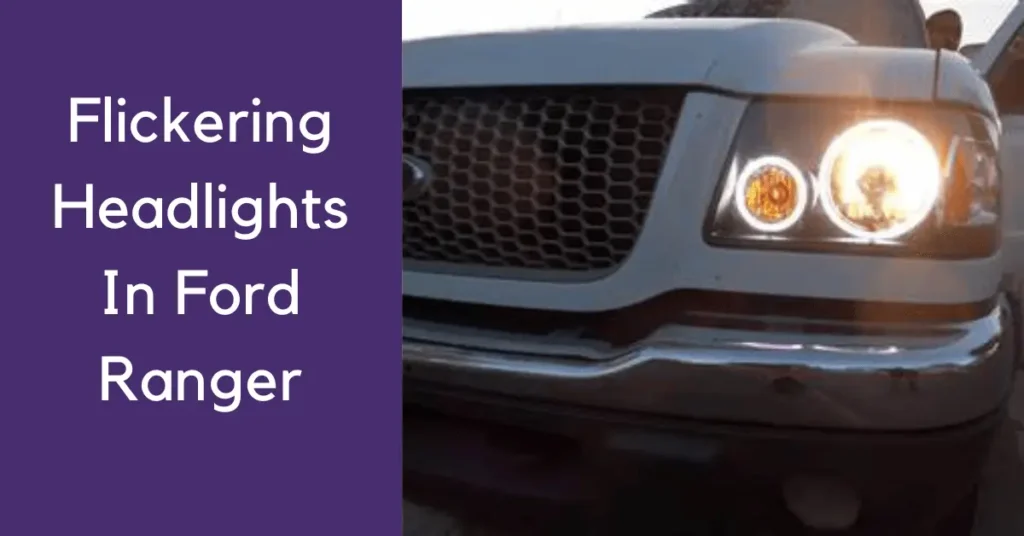
Flickering headlights are when the lights in a vehicle’s headlights keep turning on and off quickly, almost like blinking. Flickering or strobing headlights are a common problem with Ford Ranger headlights. This happens when the headlights flash on and off, making the light inconsistent. It’s not just annoying; it can also be dangerous because it makes it harder to see. Further, it can also distract other drivers.
The root cause of this problem in the Ford Ranger may lie in damaged or faulty wiring within the headlight system. Over time, vibrations, wear and tear, or incorrect installation can loosen connections within the wiring harness. This leads to inconsistent contact disrupting the smooth flow of electricity. Thus this causes flickering.
Additionally, a faulty alternator could contribute to flickering headlights in the Ford Ranger. A failing alternator may lead to fluctuations in voltage, resulting in flashing or strobing headlights.
How to fix it?
To fix flickering in the Ford Ranger caused by faulty wiring, thoroughly inspect the harness for any signs of wear, tear, or damage. Replace any visibly damaged wires or connectors.
Next, ensure all connections are secure and tight, correcting any loose fittings. Utilize electrical tape or zip ties to secure the wiring harness in place. This can prevent further vibrations or movement. Additionally, consider reinforcing the wiring with protective sheathing to safeguard against future wear and tear. Finally, double-check the installation of the wiring harness to ensure it is correctly positioned and secured within the vehicle. By addressing these steps, you can effectively resolve the root cause of the flickering headlights in the Ford Ranger.
To rectify flickering headlights in the Ford Ranger stemming from a faulty alternator, start by testing the alternator’s output voltage. You can use a multimeter for it. If the voltage output is inconsistent or below the manufacturer’s specifications, replacing the alternator is advisable. Ensure the replacement alternator is compatible with the vehicle’s make and model.
Before installation, thoroughly inspect the alternator mounting brackets and connections for any signs of damage or corrosion. Replace any worn components properly. After installing the new alternator, retest the voltage output to confirm it falls within the acceptable range. This approach should effectively address the issue of flickering headlights caused by a faulty alternator in the Ford Ranger.
#6. Water Leakage in Ford Ranger Headlights
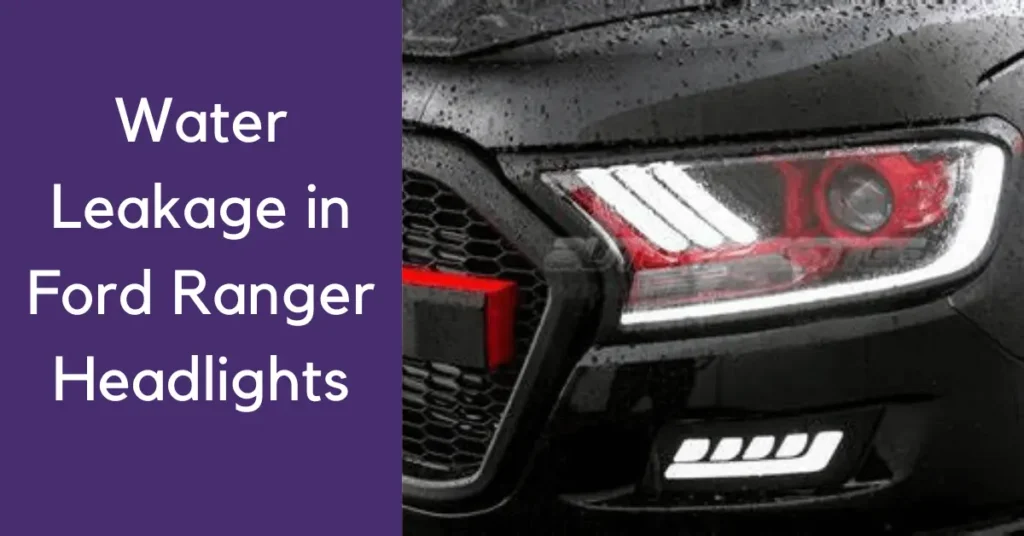
Another common one of the Ford Ranger headlight problems is water leakage. This issue may lead to reduced visibility, electrical problems, and potential damage to the headlight components. Various factors can cause water leakage. One common cause is a damaged or deteriorated headlight seal. Over time, the seal around the headlight housing can wear down. This allows water to seep in during rain or car washes.
Another possible cause is a cracked or broken headlight lens. This can create openings for water to enter the headlight assembly. Additionally, poor installation or improper sealing of the headlight housing can also lead to water leakage.
How To Fix It?
To fix water leakage in Ford Ranger headlights, it is important to first identify the source of the problem. If the headlight seal is damaged or worn out, it should be replaced with a new one. This is important to ensure a proper barrier against water intrusion. If the headlight lens is cracked or broken, it will need to be repaired or replaced. This can prevent water from entering the assembly.
Proper installation and sealing of the headlight housing is crucial in preventing further water leakage issues. It is recommended to have a professional mechanic inspect and address the water leakage problem. Thus you can ensure it is resolved effectively preventing any potential damage to the headlight components in your Ford Ranger.
5 Prevention Tips For Ford Ranger Headlight Problems

1. Regularly check and clean the headlight lenses:
Dirt, debris, and road grime can build up on the headlight lenses of the Ford Ranger. This can reduce visibility and cause the headlights to dim. Regularly cleaning the lenses can help prevent this issue.
To check and clean headlight lenses in a Ford Ranger, follow these steps:
- Mix mild soap with water or use a specialized headlight cleaning solution.
- Wet a microfiber cloth or sponge with the solution.
- Gently scrub the lenses in circular motions.
- Rinse thoroughly with clean water.
- Dry with a clean microfiber cloth.
- Optionally, apply a protective coating for future maintenance.
2. Apply a protective coating
A protective coating for headlight lenses is a clear, transparent layer applied to the surface of the lens. It provides a barrier against various environmental elements and damage. It includes UV inhibitors to prevent yellowing and brittleness caused by UV radiation. So it can serve as a barrier to stop oxidation and maintain clarity of your Ford Ranger headlights.
Additionally, some coatings offer scratch resistance, protecting against damage from debris or cleaning. The smooth surface facilitates easier cleaning. This reduces dirt adhesion and ensures optimal light transmission.
Follow the steps below to apply a protective coating on the Ford Ranger headlights by yourself:
- Prepare the headlight lens by cleaning it thoroughly with mild soap and water, then drying it with a microfiber cloth.
- Optionally, use masking tape to protect surrounding areas from overspray.
- Apply the protective coating evenly onto the headlight lens according to the manufacturer’s instructions.
- Buff the surface of the lens with a clean microfiber cloth. This can ensure an even application and remove any excess product.
- Allow the coating to cure for the recommended time to fully bond with the lens surface.
- Inspect the lens for even coverage and any imperfections once the coating is fully cured. Repeat the process if necessary for additional protection.
3. Ensuring Proper Alignment
Proper alignment of your Ford Ranger’s headlights is crucial for safety. It minimizes risks of reduced visibility and distracting other drivers. Misalignment can stem from various factors:
- Normal Wear and Tear: Components gradually shift over time, affecting alignment.
- The impact from Bumps or Potholes: Jolts from road irregularities can knock headlights out of alignment.
- Modifications or Repairs: Alterations or fixes may inadvertently affect alignment.
Indications of Misalignment:
- Irregular Light Pattern: One headlight may appear higher or lower than the other.
- Complaints from Other Drivers: If they perceive your headlights as too bright or improperly directed.
- Diminished Visibility: Difficulty in seeing the road clearly during nighttime drives.
Recommendations for Alignment:
- Professional Alignment Annually: Ensure precise and safe adjustments by certified technicians.
- Regular Checks for Misalignment: Especially after encountering bumps or potential impacts.
- Consult Owner’s Manual: Consider DIY adjustments only if supported by your model and if you possess the necessary skills and tools. However, prioritize professional servicing for optimal safety and performance.
4. Use the correct type of bulbs:
- Match the base type: Ensure the bulb’s base (screw part) fits the socket in your fixture (e.g., E26, B, G).
- Choose the right bulb type: Consider LEDs for efficiency, incandescents for warmth, fluorescents for task lighting, or halogens for accents.
- Pick the desired light effect: Select warm white for coziness, cool white for energy, or daylight for task areas.
5. Check the headlight wiring and connections
Maintaining optimal headlight visibility in a Ford Ranger requires regular checks of the wiring and connections. Faulty wiring can lead to dim or malfunctioning headlights, compromising your vision and safety. To begin checking, follow the given steps:
- Gather Flashlight, and screwdrivers (optional).
- Access: Follow your car manual to reach headlights (may involve removing parts).
- Inspect: Look for damaged, frayed, or burnt wires with your flashlight.
- Check Connections: Look for looseness or corrosion at bulb sockets, ground points, and the fuse box.
- Clean & Tighten (if needed): Gently clean minor corrosion with a wire brush. Tighten loose connections with the right screwdriver size.
- Test: Turn on the headlights and check both works properly.
- Seek Help: For complex issues or if unsure, consult a qualified mechanic.
Headlight Problems in Dodge Ram Models:
Frequently Asked Questions

1) What Tools Are Required To Fix Ford Ranger Headlights?
To service Ford Ranger headlights effectively, you’ll need to include an extra tool, making it a total of four tools. Here’s the updated list:
- Screwdriver or socket set: Depending on your Ford Ranger’s model year, you may require either a Phillips or Torx screwdriver or a socket set to loosen the screws securing the headlight assembly.
- Pliers: These may be necessary for disconnecting electrical connectors or removing clips holding the headlight assembly.
- Trim removal tool: This tool is helpful for safely and efficiently removing any trim or fasteners without causing damage to your vehicle’s exterior during the headlight repair process.
- Wire stripper/crimper: This tool helps with cutting and stripping wires for any electrical work required during the headlight repair.
- Headlamp alignment tool: Used to adjust the aim of the headlights after installation to ensure proper illumination and road safety.
- Multimeter: This device is handy for diagnosing electrical issues in the headlight system of your Ford Ranger.
2) What type of headlights does the Ford Ranger come with?
The Ford Ranger typically includes halogen headlights as the standard option across its models. However, in certain higher trim levels, such as premium or luxury editions, the vehicle may come equipped with LED headlights instead of the standard halogen ones. LED headlights offer advantages such as increased brightness, longer lifespan, and energy efficiency compared to traditional halogen lights.
3) Are The Headlight Problems And Solutions Mentioned Above Also Suitable For Other Models of Ford Ranger?
The general problems and solutions discussed about the Ford Ranger apply to various car models. However, the specific location of components and the process of accessing headlights might differ.
4) Can I upgrade my Ford Ranger’s headlights to LED?
Yes, it is possible to upgrade the headlights of your Ford Ranger to LED. There are aftermarket LED conversion kits available that can provide a brighter and more efficient lighting solution.
4) Are there any projector headlights available for the Ford Ranger?
Yes, there are aftermarket projector headlights available for the Ford Ranger. These headlights offer improved light output and a more focused beam pattern, which can enhance visibility.
Conclusion
In conclusion, these are some of the common Ford Ranger headlight problems. If you have any questions about these issues or if you’d like to share your experiences and suggestions for solutions, feel free to ask in the comments section below. Let’s engage in conversation, learn from each other, and find ways to address these issues together as a community of Ford Ranger owners.
